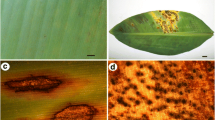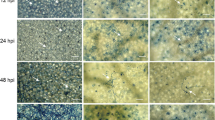Abstract
Pyrethrum (Tanacetum cinerariifolium) is commercially cultivated in Australia for the production of pyrethrins. Ray blight caused by Stagonosporopsis tanaceti is considered a major limiting factor for pyrethrum production. Histopathology of infected pyrethrum plants identified the importance of crown infection where the infection hyphae were confined to the parenchyma cells of the epidermis, hypodermis and cortex without infecting the vascular tissues. Throughout the growth of pyrethrum plants, no vascular infection occurred in the petioles, flower stems and crowns. In infected leaf petioles and flower stems, pycnidia and extra-cellular anthocyanin material developed within 1–2 weeks of infection. The symptoms of infection included a dark brown discolouration or necrosis of infected cells caused by intra- or intercellular colonisation of hyphae. Secondary infection of leaves, flower stems and flower buds most likely occurred through wind, rain or water splash of pycnidiospores released from pycnidia in the leaves and petioles. Roots of the infected plants remained uninfected throughout the growth of the plants. Detailed understanding of the disease cycle of ray blight disease in pyrethrum plants will enable the development of more efficient, targeted control measures.




Similar content being viewed by others
References
Aveskamp MM, De Gruyter J, Crous PW (2008) Biology and recent developments in the systematics of Phoma, a complex genus of major quarantine significance. Fungal Div 31:1–18
Barimani M, Pethybridge SJ, Vaghefi N, Hay FS, Taylor PWJ (2013) A new anthracnose disease of pyrethrum caused by Colletotrichum tanaceti sp. nov. Plant Pathol 62(6):1248–1257
Bhuiyan MAHB, Groom T, Nicolas ME, Taylor PWJ (2015) Histopathology of S. tanaceti infection in pyrethrum leaf lamina. Australas Plant Pathol 44(6):629–636
Bhuiyan MAHB, Groom T, Nicolas ME, Taylor PWJ (2016) Infection process of S. tanaceti in pyrethrum seeds and seedlings. Plant Pathol. doi:10.1111/ppa.12622
Casida JE (1980) Pyrethrum flowers and pyrethroid insecticides. Environ Health Perspect 34:189
Castell-Miller CV, Zeyen RJ, Samac DA (2007) Infection and development of Phoma medicaginis on moderately resistant and susceptible alfalfa genotypes. Can J Plant Pathol 29(3):290–298
Hay FS, Gent DH, Pilkington SJ, Pearce TL, Scott JB, Pethybridge SJ (2015) Changes in distribution and frequency of fungi associated with a foliar disease complex of pyrethrum in Australia. Plant Dis 99(9):1227–1235
Howlett BJ, Idnurm A, Pedras MSC (2001) Leptosphaeria maculans, the causal agent of blackleg disease of brassicas. Fungal Gen Biol 33(1):1–14
Pearce TL, Scott JB, Crous PW, Pethybridge SJ, Hay FS (2016) Tan spot of pyrethrum is caused by a Didymella species complex. Plant Pathol 65:170–1184
Pethybridge SJ, Hay FS, Groom T (2003) Seasonal fluctuations in fungi associated with pyrethrum foliage in Tasmania. Australas Plant Pathol 32(2):223–230
Pethybridge SJ, Hay FS, Wilson CR (2004) Pathogenicity of fungi commonly isolated from foliar disease in Tasmanian pyrethrum crops. Australas Plant Pathol 33(3):441–444
Pethybridge SJ, Esker P, Hay F, Wilson C, Nutter FW Jr (2005) Spatiotemporal description of epidemics caused by Phoma ligulicola in Tasmanian pyrethrum fields. Phytopathol 95(6):648–658
Pethybridge SJ, Jones SJ, Shivas RG, Hay FS, Wilson CR, Groom T (2008) Tan spot: a new disease of pyrethrum caused by Microsphaeropsis tanaceti sp. nov. Plant Pathol 57(6):1058–1065
Pethybridge SJ, Gent DH, Esker PD, Turechek WW, Hay FS, Nutter FW Jr (2009) Site-specific risk factors for ray blight in Tasmanian pyrethrum fields. Plant Dis 93(3):229–237
Pethybridge SJ, Gent DH, Hay FS (2011) Epidemics of ray blight on pyrethrum are linked to seed contamination and overwintering inoculum of Phoma ligulicola var. inoxydabilis. Phytopathol 101(9):1112–1121
Pethybridge SJ, Gent DH, Groom T, Hay FS (2013) Minimizing crop damage through understanding relationships between pyrethrum phenology and ray blight disease severity. Plant Dis 97(11):1431–1437
Rai MK (1985) Taxonomic studies of species of Phoma isolated from air. J Econ Taxon Bot 7(3):645–647
Stone JK, Capitano BR, Kerrigan JL (2008) The histopathology of Phaeocryptopus gaeumannii on Douglas-fir needles. Mycologia 100(3):431–444
Suraweera DD, Nicolas ME, Groom T (2016) Effect of short periods of heat stress during early flowering period on flower development and pyrethrin accumulation in pyrethrum. Acta Hortic 1125:121–128
Vaghefi N, Pethybridge S, Ford R, Nicolas M, Crous P, Taylor P (2012) Stagonosporopsis spp. associated with ray blight disease of Asteraceae. Australas Plant Pathol 41(6):675–686
Vaghefi N, Ades PK, Hay FS, Pethybridge SJ, Ford R, Taylor PWJ (2015a) Identification of the MAT1 locus in Stagonosporopsis tanaceti, and exploring its potential for sexual reproduction in Australian pyrethrum fields. Fungal Biol 119(5):408–419
Vaghefi N, Hay FS, Ades P, Pethybridge SJ, Ford R, Taylor PWJ (2015b) Rapid changes in the genetic composition of Stagonosporopsis tanaceti population in Australian pyrethrum fields. Phytopathol 105(3):358–369
Zito SW (1994) Chrysanthemum cinerariaefolium (Pyrethrum): In vitro culture and the production of pyrethrins and other secondary metabolites. In: Medicinal and Aromatic Plants VI. Springer Berlin Heidelberg, pp 56–68
Acknowledgements
This project was supported by Botanical Resources Australia (BRA)-Agricultural Services Pty. Ltd.
Author information
Authors and Affiliations
Corresponding author
Rights and permissions
About this article
Cite this article
Bhuiyan, M.A.H.B., Groom, T., Nicolas, M.E. et al. Disease cycle of Stagonosporopsis tanaceti in pyrethrum plants. Australasian Plant Pathol. 46, 83–90 (2017). https://doi.org/10.1007/s13313-016-0459-7
Received:
Accepted:
Published:
Issue Date:
DOI: https://doi.org/10.1007/s13313-016-0459-7




